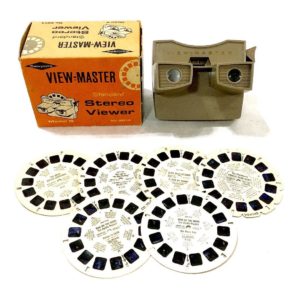
There was a tiny little world that I remember entering as a child. To get there, you had to use an object that required you to point it to a bright light source. Once you did so, you peered through the eyepieces and observed a miracle: gorgeous color images of national parks, cartoon characters, or perhaps animals in incredible three-dimensional realism!
A Viewmaster was found in practically every house with kids in the 1960’s. Perhaps one reason for its popularity was that it wasn’t just fascinating to the young! Parents got a kick out of them too.
The Viewmaster actually predates the Baby Boomer generation. It was debuted at the New York World’s Fair in 1939. It was invented by organ maker and photographer William Gruber, who wanted to create a stereoscopic way to view recently invented Kodachrome slides.
The product was inexpensive from the start, and this contributed to its popularity. And it also contained few moving parts and required no batteries. Plus, it established a standard size for the Viewmaster reel, or disk, that let you view the latest releases on the oldest Viewmaster, or vice versa.
And they also opened up a wonderful world to kids. We saw stunning images of Yosemite, Yellowstone, New York skyscrapers, massive mountain ranges, and, of course, Donald Duck.
The fact that every kid had one meant that visiting your friends’ homes would give you access to reels you might have never seen before. A Viewmaster sitting out with a few reels would quickly be grabbed up and checked out by visiting playmates.
After several ownership changes, the rights to Viewmaster were eventually purchased by Fisher-Price, who still manufacture them today. In fact, you can buy a brand spanking new viewer for six bucks. It doesn’t look much like the pictured vintage model, but it works the same.
How about it, fellow Boomers? Why not introduce your grandkids to the same wonderful 3-D world you remember as a child?